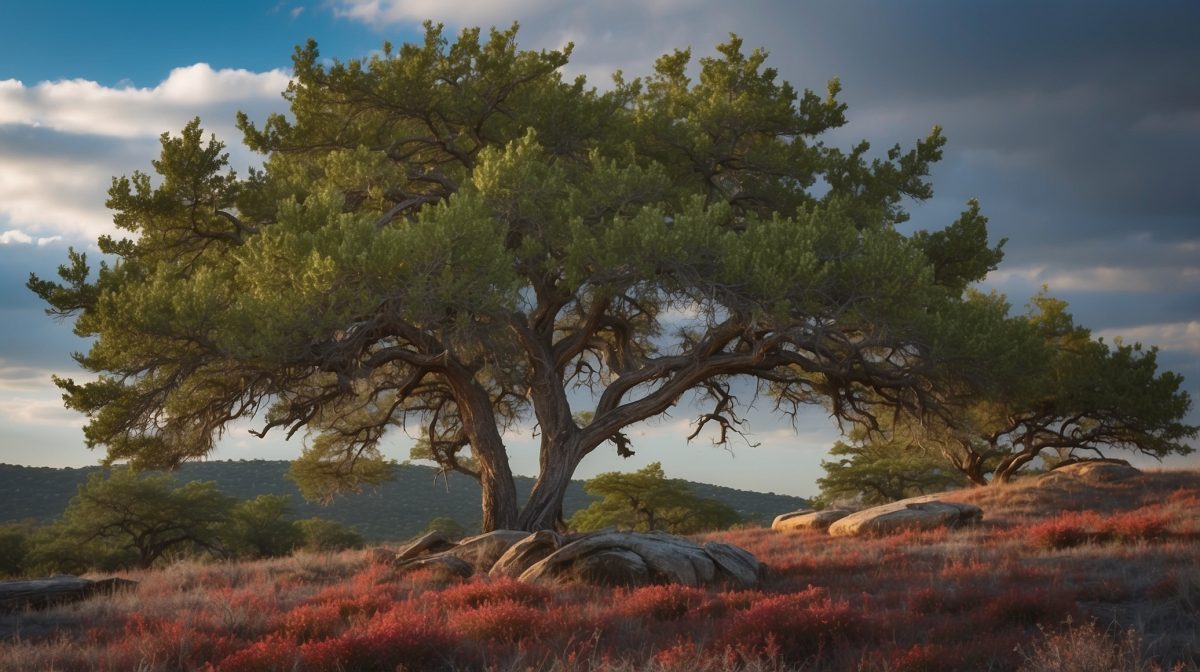The Ashe Juniper is more than just a tree ’round these parts; it’s a piece of our natural heritage. Its ability to withstand the Hill Country’s rugged terrain makes it a symbol of our own resilience. But to keep our ecosystem balanced and bountiful, we’ve got to handle these trees with care, especially when we’re moving ’em from one spot to another. So, let’s roll up our sleeves and get to transplantin’ the right way.
Understanding the Wild Ashe Juniper
First off, let’s talk about what makes the Ashe Juniper a true Hill Country classic. This sturdy evergreen sports bluish berries and a thick, shaggy bark that’s as rugged as the landscape itself. Standing tall against the Texas sky, these trees can live for centuries, growin’ right alongside generations of Texans.
But it ain’t just about looks; the Ashe Juniper plays a crucial role in our local ecosystem. It offers shelter for wildlife, stabilizes the soil, and even helps out with water retention. Historically, it’s been used for fence posts, building materials, and even as a natural remedy by the Native Americans. This tree ain’t just wood and leaves; it’s a living piece of our culture.
Pre-Transplant Considerations
Now, if you’re thinkin’ about relocating one of these beauties, timing is everything. The best time for transplantin’ in the Texas Hill Country is late fall to early winter. That’s when the tree’s growth slows down, and it can settle into its new home without too much stress. You’ll also want to pick a healthy young’un with a good root system and a shape that sings to your soul.
Before you get to diggin’, you’ve got to reckon with the land. The spot you choose for your Ashe Juniper should have the right kind of soil – not too rocky, not too sandy – and enough sunlight to make a lizard smile. Remember, you’re not just plantin’ a tree; you’re settin’ the stage for a lifetime of growth.
Transplantation Preparation
Alright, let’s gear up. You’ll need a shovel, some gloves, a bit of burlap, and a whole lot of gumption. It’s important to give the tree a good drink before you start, so its roots are hydrated and happy. Then, gently tie up the branches to keep ’em safe during the move. It’s like packin’ up your grandma’s fine china – handle with care.
Over at the new digs, you’ll want to prep the soil to welcome your tree. A nice hole, about twice the width of the root ball but no deeper, should do the trick. Mix in some compost if the soil’s lookin’ tired, and give it a good waterin’. You’re not just plantin’ a tree; you’re layin’ down roots for the future.
The Transplanting Process
Now, the main event: movin’ the Ashe Juniper. Start by diggin’ a generous circle around the tree, takin’ care not to damage those precious roots. Once you’ve freed it from the earth, wrap the root ball in burlap to keep it together. Lift with your legs, not your back – we’re gardenin’, not lookin’ for aches and pains.
Transportin’ your tree is next. Whether it’s on the back of a truck or the end of a wheelbarrow, keep it steady and secure. At the new site, ease the tree into the hole and fill ’round the roots with soil, tamping it down as you go. Make sure it’s standin’ straight, like a Texan should, and brace it with stakes if needed. You’re not just plantin’ a tree; you’re settin’ a sentinel for the skyline.
Post-Transplant Care
Once your Ashe Juniper is settled, it’ll need some TLC. Water it deeply and regularly, but don’t drown the poor thing. Think of it like a good stew – simmer, don’t boil. A layer of mulch will help keep the moisture in and the weeds out, like a cozy blanket on a chilly Hill Country night.
Keep an eye on your tree as it grows. A bit of fertilizer in the spring can give it a boost, but don’t overdo it. Watch for signs of happiness – new growth, a sturdy stance, and that certain twinkle in its needles. You’re not just growin’ a tree; you’re nurturing a piece of the Texas Hill Country.
Trouble-shooting Common Issues
Even with the best care, sometimes a tree gets the blues. Transplant shock can leave an Ashe Juniper lookin’ a bit wilted, but don’t fret. Keep up with the waterin’ and talk to it – yes, I said talk to your tree. A little encouragement goes a long way. And if pests or diseases come knockin’, deal with ’em promptly, like you would any unwelcome varmint.
Prunin’ your tree might be necessary down the line, but it’s not a job for the overeager. Wait until the tree is established and only trim what’s needed. Think of it as a haircut – you’re aimin’ for a trim, not a buzz cut. You’re not just carin’ for a tree; you’re sculptin’ a legacy.
Conclusion
Well, there you have it, partners – your guide to transplantin’ wild Ashe Juniper in the Texas Hill Country. Remember, it’s all about respectin’ the tree and the land. Follow these steps, and you’ll be rewarded with a landscape that’s as Texan as a sunset over the ranch.
And there’s nothin’ quite like the satisfaction of seein’ a tree you’ve transplanted thrive and grow. It’s a little bit of work for a whole lot of joy, and a contribution to the beauty of our beloved Hill Country. So go ahead, give it a try – your Ashe Juniper is countin’ on you.
FAQs
What makes the Ashe Juniper so special to Texas Hill Country?
The Ashe Juniper is special because it’s a hardy native tree that’s adapted to our unique landscape, provides habitat for wildlife, and has deep cultural roots in our history.
How long does it take for a transplanted Ashe Juniper to become established?
It can take a transplanted Ashe Juniper about one to two years to become fully established, so give it time and care.
Can I transplant an Ashe Juniper during the Texas summer?
It’s best to avoid the summer heat for transplanting. Late fall to early winter is the ideal time when the tree is less active.
How do I know if my soil is right for Ashe Juniper?
Your soil should be well-draining and not too rocky or sandy. You can get a soil test kit to check the conditions or consult with a local nursery.
What should I do if my transplanted Ashe Juniper starts to look unhealthy?
Make sure it’s getting the right amount of water and not showing signs of pests or diseases. If problems persist, seek advice from a local arborist or nursery.


